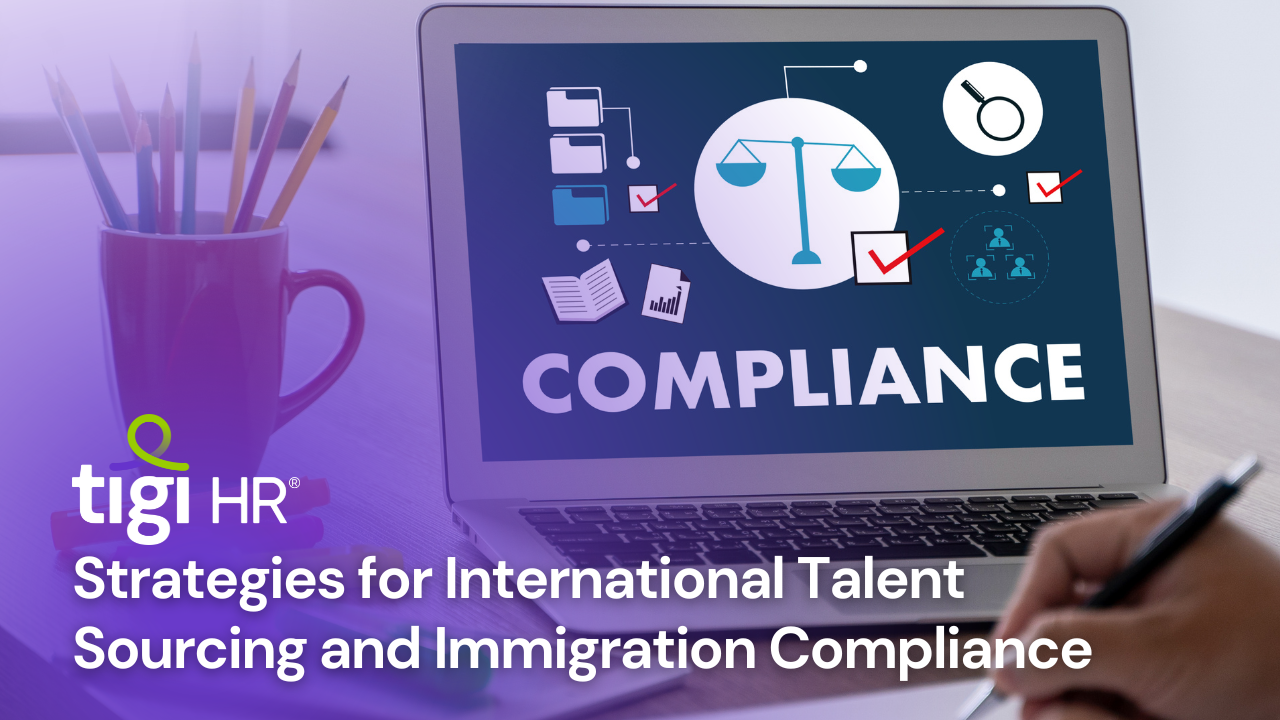The Importance of International Talent Sourcing
In today’s globalized economy, the importance of international talent sourcing cannot be overstated. As businesses expand across borders, the need for a diverse and skilled workforce transcending geographical boundaries has become a strategic imperative. International talent sourcing, the practice of recruiting and hiring individuals from around the world, brings a wealth of benefits to organizations aiming for growth, innovation, and competitiveness.
Insights:
Diversity and Innovation: International talent brings a rich mix of perspectives, skills, and cultural insights. This diversity fuels innovation, fostering the development of creative solutions to complex problems. Research indicates that companies with diverse workforces are 35% more likely to outperform their industry peers.
Addressing Skill Gaps: In many industries, there’s a growing gap between the skills required and the skills available locally. International talent sourcing allows companies to bridge these gaps by tapping into a global pool of highly qualified professionals.
Market Expansion: Entering new markets often requires an understanding of local customs, languages, and regulations. Hiring international talent with local expertise can significantly enhance a company’s ability to navigate foreign markets and establish a strong presence.
Statistics:
According to a McKinsey report, ethnically diverse companies are 33% more likely to outperform their peers in profitability.
The United Nations estimates that there were 281 million international migrants in 2020, making up 3.6% of the world’s population. This vast pool of potential talent is waiting to be tapped.
A study by the National Bureau of Economic Research found that the hiring of high-skilled immigrants in the United States has a positive impact on the wages of native-born workers, as it stimulates economic growth.
Understanding Immigration Compliance
Understanding immigration compliance is a critical aspect of international talent sourcing. Navigating the complex web of immigration laws and regulations is essential for businesses seeking to hire foreign talent while avoiding legal pitfalls. In an era of increasing scrutiny and evolving immigration policies, it’s vital to be well-informed and proactive in ensuring compliance.
Insights:
Changing Immigration Landscape: Immigration laws and policies can change frequently. Understanding the latest developments is crucial to avoid compliance issues. For instance, the COVID-19 pandemic triggered temporary changes in immigration regulations in many countries, impacting travel and work restrictions.
Penalties for Non-Compliance: Non-compliance with immigration regulations can result in serious consequences for businesses, including fines, legal actions, and reputational damage. Ensuring compliance not only protects the organization but also the individuals involved.
Work Authorization Documentation: Different countries have specific requirements for work authorization documentation. Understanding these requirements, such as visas, permits, and work visas, is essential to legally employ international talent.
Statistics:
A report from the National Foundation for American Policy found that denial rates for H-1B visas (commonly used for high-skilled foreign workers in the U.S.) increased significantly from 6% in FY 2015 to 32% in FY 2019. This illustrates the growing challenges in obtaining work visas.
In the European Union, where free movement of labor is a key principle, understanding the evolving immigration landscape post-Brexit is crucial. The EU Settlement Scheme saw over 6 million applications by EU and EEA citizens in the UK by June 2021, highlighting the impact of policy changes.
The Migration Observatory reports that the COVID-19 pandemic brought about a wave of temporary immigration policy changes globally. Understanding these shifts is essential for businesses aiming to navigate travel restrictions and work authorizations.
In summary, understanding immigration compliance is a fundamental aspect of international talent sourcing. It requires vigilance, a commitment to staying up-to-date with regulatory changes, and a dedication to following the law. Ensuring compliance not only mitigates risks but also contributes to a positive and lawful business environment.
Global Workforce Trends
Global workforce trends are continually evolving in response to economic, technological, and societal shifts. Understanding these trends is essential for organizations engaged in international talent sourcing, as it enables them to adapt and stay competitive in a dynamic global labor market.
Insights:
Remote Work Revolution: The COVID-19 pandemic accelerated the adoption of remote work. As a result, organizations are increasingly open to hiring talent from anywhere in the world. This trend offers greater flexibility and access to a broader talent pool.
Skill Mobility: Skills have become more mobile than ever. Highly skilled professionals are seeking opportunities globally, making it imperative for companies to cast a wider net when sourcing talent.
Aging Workforce and Talent Shortages: Many developed nations are experiencing an aging workforce. This demographic shift is driving a demand for international talent, especially in sectors with skill shortages.
Statistics:
A Gartner survey in 2020 found that 82% of company leaders planned to allow employees to work remotely, at least part of the time. Remote work has become a global phenomenon.
According to the World Economic Forum, the global skills gap is expected to reach 85 million job vacancies by 2030, highlighting the urgency of sourcing talent from a broader international pool.
A study by the United Nations Department of Economic and Social Affairs projects that the world’s working-age population (25-64 years) will decline from 67% in 2020 to 63% by 2100. This shift underscores the importance of international talent sourcing to address demographic challenges.
Cross-Border Talent Acquisition Challenges
Cross-border talent acquisition presents a unique set of challenges for organizations looking to source international talent. While the benefits are evident, navigating these hurdles is crucial for a successful global recruitment strategy.
Insights:
Cultural Barriers: Cultural differences can impact communication, collaboration, and employee integration. Organizations must address these challenges by fostering cultural awareness and inclusion.
Legal and Regulatory Complexities: Each country has its own immigration laws, employment regulations, and visa requirements. Keeping up with these complex and ever-changing legal frameworks is vital to avoid compliance issues.
Language and Communication: Effective communication is essential for successful cross-border talent acquisition. Language barriers can hinder the recruitment process and ongoing collaboration. Strategies for overcoming language challenges are crucial.
Statistics:
According to the Global Talent Acquisition and Staffing Technology report, 60% of employers believe that cultural fit is the most important factor in international hiring.
The Deloitte Global Human Capital Trends report highlights that 70% of organizations see increased regulatory and compliance demands as a top challenge in global talent acquisition.
The Common Sense Advisory reports that 75% of global consumers prefer to buy products in their native language, emphasizing the importance of language and communication in cross-border hiring.
Best Practices for Recruiting International Talent
Recruiting international talent is a strategic imperative for many organizations aiming to thrive in a globalized world. To excel in this endeavor, it’s essential to adopt best practices that not only attract top talent but also streamline the hiring process and promote long-term success.
Insights:
Clear Job Descriptions: Crafting detailed job descriptions is critical. They should specify job requirements, responsibilities, and expectations clearly, making it easier for international candidates to assess their suitability.
Global Outreach: Effective international talent sourcing requires a global approach. Organizations should leverage job boards, recruitment agencies, and professional networks worldwide to access a diverse pool of talent.
Streamlined Interview Processes: Streamlined interviews, possibly through virtual means, can expedite the hiring process and reduce time-to-hire, a key metric for success in international recruiting.
Statistics:
According to LinkedIn’s Global Talent Trends report, 73% of talent professionals believe that company culture and values are critical for attracting international talent. Ensuring these values are well-communicated in job postings and interviews is essential.
The SHRM (Society for Human Resource Management) reports that using technology, such as video interviews, can reduce time-to-hire by up to 70%. This emphasizes the value of streamlined interview processes in international recruitment.
The World Employment and Social Outlook – Trends 2020 by the International Labour Organization (ILO) suggests that the global supply of skilled labor will exceed demand, indicating the potential for organizations to find talent internationally.
Work Visa and Immigration Regulations
Navigating work visa and immigration regulations is a pivotal aspect of international talent sourcing. Understanding the intricacies of these regulations is essential for organizations aiming to hire foreign talent while remaining compliant with the law.
Insights:
Visa Categories: Different countries offer various visa categories for foreign workers, including skilled workers, intracompany transfers, and student visas. Understanding the appropriate visa category for each hire is essential to avoid legal issues.
Immigration Processes: The processes for obtaining work visas can be time-consuming and complex. It’s important to have a well-defined process in place, from visa application to renewal and potential paths to permanent residency.
Changing Policies: Immigration policies can change rapidly in response to political, economic, or social factors. Organizations must stay informed about these changes to adapt their hiring strategies accordingly.
Statistics:
According to the Migration Policy Institute, the United States issued more than 180,000 H-1B visas in 2019, primarily for high-skilled workers. This data illustrates the demand for foreign talent in the U.S. job market.
A study by the Pew Research Center found that the number of international students studying in the United States surpassed one million in 2019, showcasing the significance of student visas in international education and talent sourcing.
The World Bank reports that global remittances from international migrants reached over $700 billion in 2020. This financial flow demonstrates the substantial contributions of international workers to both home and host countries’ economies.
Navigating Immigration Paperwork
Navigating immigration paperwork is a fundamental component of international talent sourcing. The process of obtaining the necessary visas and permits can be intricate, but a well-structured approach can ensure a smoother experience for both employers and international hires.
Insights:
Documentation Requirements: Different countries have specific documentation requirements for work visas, permits, and immigration processes. Understanding these requirements and preparing the necessary paperwork is a crucial step in the international hiring process.
Timelines and Deadlines: Immigration paperwork often comes with specific timelines and deadlines that must be adhered to. Missing these deadlines can lead to delays or even the rejection of visa applications.
Professional Assistance: Many organizations choose to enlist the help of immigration experts or legal professionals to navigate the intricacies of immigration paperwork. This assistance can streamline the process and reduce the risk of errors.
Statistics:
The U.S. Department of State reported that the processing time for a U.S. employment-based immigrant visa can vary significantly, depending on the visa category and the applicant’s country of origin. This underscores the importance of understanding timelines in immigration processes.
According to a survey by the National Foundation for American Policy, 94% of employers stated that they had experienced delays in immigration-related processes, which affected their ability to hire and retain international talent.
The Global Immigration Benchmark Report by Newland Chase and CIBT Visa’s findings revealed that 69% of global immigration professionals believe that immigration policies and practices have become more restrictive, impacting the ease of international hiring.
Diversity and Inclusion in International Hiring
Diversity and inclusion in international hiring have become pivotal considerations for organizations looking to foster innovation and better serve global markets. Embracing a diverse workforce is not only a moral imperative but also a strategic advantage in today’s interconnected world.
Insights:
Innovation and Creativity: Diverse teams are more likely to generate innovative ideas and creative solutions. Different cultural perspectives and experiences can lead to a wider range of problem-solving approaches.
Market Sensitivity: International hiring allows organizations to better understand and serve diverse customer bases. A workforce that mirrors the diversity of your target markets can enhance your market sensitivity and competitiveness.
Talent Retention: Fostering an inclusive environment is crucial for retaining international talent. A supportive workplace culture promotes higher employee satisfaction and reduces turnover.
Statistics:
McKinsey’s “Diversity Wins” report found that companies in the top quartile for ethnic and cultural diversity on their executive teams were 36% more likely to achieve above-average profitability.
A study by BCG revealed that companies with more diverse management teams have 19% higher revenue due to innovation.
A survey conducted by Glassdoor showed that 67% of job seekers consider diversity an important factor when evaluating companies and job offers.
Employer Sponsorship Programs
Employer sponsorship programs play a crucial role in international talent sourcing, allowing organizations to attract and retain foreign talent by assisting with the necessary legal and administrative aspects of relocation and work authorization.
Insights:
Attracting Top Talent: Employer sponsorship programs are attractive to international candidates as they alleviate the complexities of immigration, providing a clear path to work and live in a new country.
Retention and Loyalty: Employees sponsored by their employers tend to exhibit higher loyalty and commitment, as the organization’s support fosters a sense of belonging and security in a foreign environment.
Legal Compliance: Sponsorship programs ensure that the organization remains compliant with immigration laws and regulations, reducing the risk of legal issues.
Statistics:
According to the National Foundation for American Policy, 79% of international students in the United States were more likely to accept job offers from employers who sponsored their work visas.
The Pew Research Center reported that in the United States, the H-1B visa program, a common sponsorship route for high-skilled foreign workers, saw an approval rate of 87% in 2020.
A study by Envoy Global found that 58% of employers believe that U.S. immigration policies have made it more challenging to hire and retain foreign talent, highlighting the importance of robust employer sponsorship programs.
Talent Sourcing in Emerging Markets
Talent sourcing in emerging markets has become a strategic priority for organizations seeking growth opportunities and a competitive edge. These markets offer unique advantages and challenges in the quest for international talent.
Insights:
Growth Potential: Emerging markets often exhibit faster economic growth and a rising middle class. Sourcing talent from these regions positions organizations to tap into growing consumer bases and expanding industries.
Local Expertise: Accessing local talent provides a deep understanding of regional markets, regulatory nuances, and cultural dynamics, which can be invaluable for market entry and expansion.
Challenges of Competition: While emerging markets hold promise, they can also be competitive talent landscapes, with high demand for skilled professionals. Companies need innovative strategies to attract and retain top talent.
Statistics:
According to the World Bank, emerging markets are expected to grow by 4.4% in 2023, exceeding the growth rates of advanced economies. This highlights the potential for businesses in these regions.
A survey by EY found that 85% of executives believe emerging markets are crucial for their growth strategies, emphasizing the significance of talent sourcing in these regions.
Research by PwC shows that 88% of CEOs are concerned about the availability of key skills in emerging markets, indicating the need to proactively source and develop talent in these areas.
Impact of COVID-19 on International Talent Sourcing
The COVID-19 pandemic has had a profound impact on international talent sourcing, reshaping the way organizations recruit and manage their global workforce. Understanding these changes is essential in adapting to the new realities of the global job market.
Insights:
Remote Work Surge: The pandemic accelerated the adoption of remote work, enabling organizations to source talent from anywhere in the world. This shift has opened up new possibilities for hiring and managing international employees.
Travel Restrictions and Visa Challenges: COVID-19 led to travel restrictions and delays in visa processing, making it more challenging for international talent to relocate. Many organizations had to adapt to these hurdles.
Digital Transformation: The pandemic accelerated digital transformation efforts. Organizations now rely on technology for virtual interviews, onboarding, and collaboration, impacting the way international talent is sourced and integrated.
Statistics:
According to a Gartner survey, 88% of organizations encouraged or required employees to work from home during the pandemic. This shift highlights the increased importance of remote work arrangements.
The United Nations reported that international travel fell by 74% in 2020, leading to significant disruptions in global mobility and international talent movement.
Research by Deloitte found that 69% of organizations had accelerated their digital transformation efforts due to the pandemic, with a focus on technology for remote work and virtual collaboration.
Legal Considerations in Hiring International Talent
Navigating the legal aspects of hiring international talent is paramount for organizations looking to expand their global workforce. Adhering to immigration laws, employment regulations, and visa requirements is not only a legal obligation but also critical for a successful international hiring strategy.
Insights:
Compliance and Risk Mitigation: Compliance with immigration laws and employment regulations is crucial for avoiding legal issues. Staying up-to-date with changing legal requirements reduces the risk of penalties, fines, and reputational damage.
Proactive Planning: Developing a clear understanding of legal considerations and proactively planning for them is essential. Employers need to have a robust legal framework in place, from visa applications to managing work authorizations.
Global Mobility Expertise: Employing individuals with expertise in global mobility and immigration laws or consulting with legal professionals is a prudent approach to ensure legal compliance throughout the hiring process.
Statistics:
The Migration Policy Institute reported that in the United States, the number of foreign-born individuals in the workforce reached 27.2 million in 2019. This emphasizes the significance of understanding and complying with immigration laws.
A survey by Newland Chase and CIBT Visa found that 79% of global immigration professionals believe immigration policies and practices have become more restrictive. Navigating these restrictions necessitates a thorough understanding of the legal landscape.
According to the World Economic Forum, 59% of global executives see legal and regulatory issues as a significant obstacle to international expansion. Understanding and effectively addressing legal considerations is key to overcoming these challenges.
Managing Cultural Differences in the Workplace
Managing cultural differences in the workplace is a critical aspect of international talent sourcing. A culturally diverse workforce can bring unique perspectives and skills, but it also requires effective management to harness its full potential.
Insights:
Cultural Competency: Organizations must foster cultural competency among their employees and leadership. This includes understanding and respecting diverse customs, communication styles, and work habits.
Conflict Resolution: Differences in cultural norms can lead to misunderstandings and conflicts. Organizations need to implement effective conflict resolution strategies to address these issues promptly and constructively.
Inclusivity: A culture of inclusivity is key. It ensures that all employees, regardless of their cultural background, feel valued, respected, and able to contribute their best to the organization.
Statistics:
The Harvard Business Review found that companies with diverse workforces are 45% more likely to report that they had captured a larger share of their target market. This illustrates the relationship between cultural diversity and market success.
A survey by Deloitte found that 83% of executives and 79% of employees believe that a diverse workforce enhances creativity and innovation, emphasizing the link between cultural diversity and innovative problem-solving.
According to the Global Human Capital Trends report by Deloitte, 74% of organizations consider diversity and inclusion as an important issue, recognizing that these factors are integral to attracting and retaining international talent.
Conclsion
In today’s globalized and interconnected world, international talent sourcing has become a strategic imperative for organizations aiming to stay competitive, foster innovation, and access diverse skill sets. The diverse subtopics we’ve explored underscore the multifaceted nature of this endeavor and the critical factors that shape its success.
Understanding the importance of international talent sourcing is the first step in the process. The global workforce trends, including the rise of remote work and the emergence of emerging markets, offer valuable opportunities for organizations to tap into a rich talent pool worldwide. The impact of the COVID-19 pandemic has reshaped recruitment practices, emphasizing the need for adaptability in the face of unprecedented challenges.
Navigating the intricacies of work visa and immigration regulations is a fundamental consideration, as non-compliance can lead to legal issues and hinder international recruitment efforts. The role of employer sponsorship programs in attracting and retaining foreign talent is significant, offering support and guidance through the immigration process.
Diversity and inclusion have taken center stage, highlighting the importance of fostering a culturally diverse and inclusive work environment, not only as an ethical imperative but as a driver of innovation and success.
Legal considerations are a foundational aspect of international talent sourcing, emphasizing the necessity of understanding and adhering to immigration laws, employment regulations, and visa requirements.
Furthermore, the subtopic of managing cultural differences underscores the importance of cultural competency, conflict resolution, and inclusivity in harnessing the full potential of a diverse workforce.
In conclusion, international talent sourcing is not just about recruitment; it’s a strategic endeavor that encompasses legal, cultural, and global considerations. Organizations that recognize these complexities and adapt to the changing global landscape will be best positioned to thrive in an increasingly interconnected world. As they tap into the diverse skills, experiences, and perspectives of international talent, they will gain a competitive edge and foster a culture of innovation that fuels their long-term success.
Candidate Relationship Management: Building Long-Term Talent Connections
Candidate Relationship Management (CRM) is a transformative approach in talent acquisition. Through personalization, technology, and data analysis, CRM builds trust, fosters quality hires, and reduces recruitment costs. However, implementing CRM can pose challenges, from data privacy to change management. Successful case studies and emerging trends in AI and diversity emphasize the ongoing evolution of CRM in the recruitment landscape
Find trusted recruitment agencies : Click here





